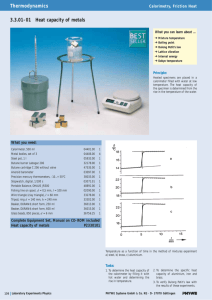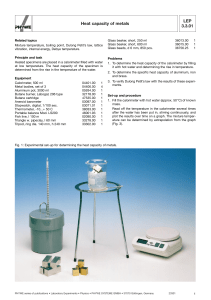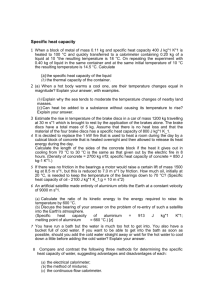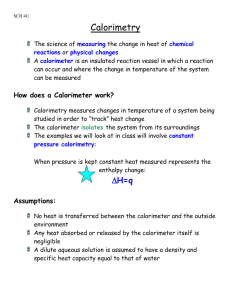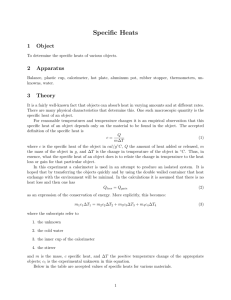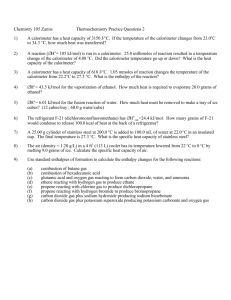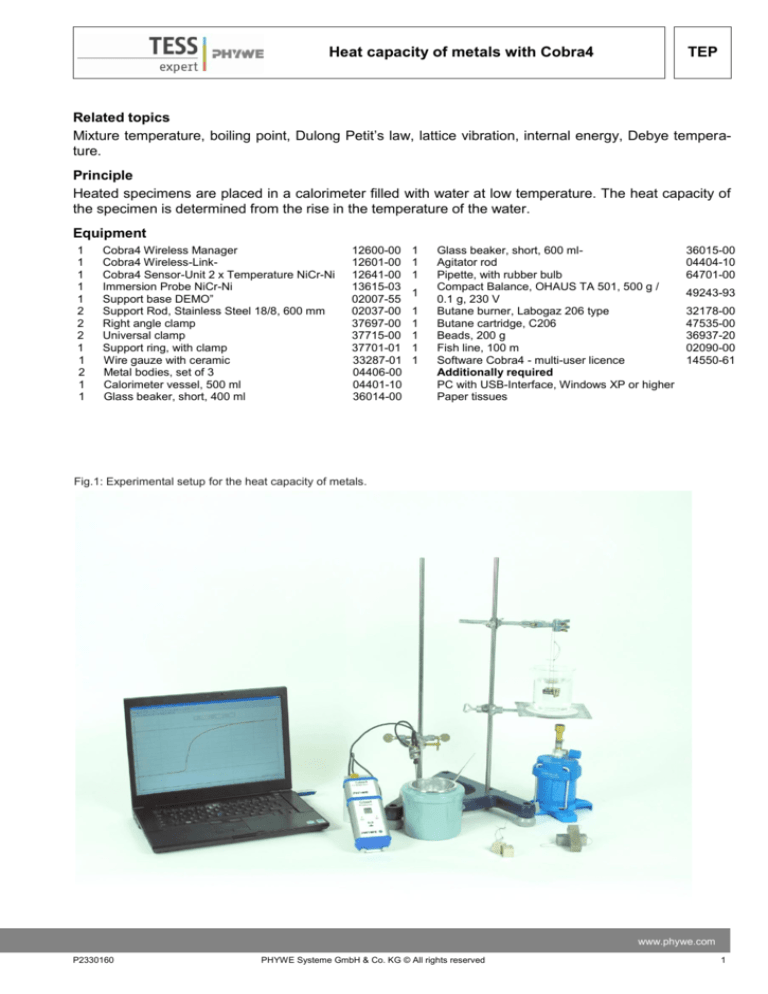
Heat capacity of metals with Cobra4
TEP
Related topics
Mixture temperature, boiling point, Dulong Petit’s law, lattice vibration, internal energy, Debye temperature.
Principle
Heated specimens are placed in a calorimeter filled with water at low temperature. The heat capacity of
the specimen is determined from the rise in the temperature of the water.
Equipment
1
1
1
1
1
2
2
2
1
1
2
1
1
Cobra4 Wireless Manager
Cobra4 Wireless-LinkCobra4 Sensor-Unit 2 x Temperature NiCr-Ni
Immersion Probe NiCr-Ni
Support base DEMO”
Support Rod, Stainless Steel 18/8, 600 mm
Right angle clamp
Universal clamp
Support ring, with clamp
Wire gauze with ceramic
Metal bodies, set of 3
Calorimeter vessel, 500 ml
Glass beaker, short, 400 ml
12600-00
12601-00
12641-00
13615-03
02007-55
02037-00
37697-00
37715-00
37701-01
33287-01
04406-00
04401-10
36014-00
1
1
1
1
1
1
1
1
1
Glass beaker, short, 600 mlAgitator rod
Pipette, with rubber bulb
Compact Balance, OHAUS TA 501, 500 g /
0.1 g, 230 V
Butane burner, Labogaz 206 type
Butane cartridge, C206
Beads, 200 g
Fish line, 100 m
Software Cobra4 - multi-user licence
Additionally required
PC with USB-Interface, Windows XP or higher
Paper tissues
36015-00
04404-10
64701-00
49243-93
32178-00
47535-00
36937-20
02090-00
14550-61
Fig.1: Experimental setup for the heat capacity of metals.
www.phywe.com
P2330160
PHYWE Systeme GmbH & Co. KG © All rights reserved
1
TEP
Heat capacity of metals with Cobra4
Tasks
1. Determine the specific heat capacity of aluminium, iron and brass.
2. To verify Dulong Petit’s law with the results of these experiments.
Setup
The experimental setup is shown in Fig.1.
Fill a 600 ml glass beaker with water at room temperature as a reserve vessel for the calorimeter. Connect the Cobra4 Wireless Manager to a USB port of the computer, plug the Cobra4 Sensor-Unit
2 x Temperature NiCr-Ni on the Cobra4 Wireless-Link and connect the thermoelement.
Fill 200 g of water at room temperature (m1) in the calorimeter. Tie two aluminium test pieces together
with fishing line and do the same with two iron and three brass pieces. Fill a 400 ml glass beaker with
about 300 ml of water. Immerse all the metallic bodies in this water bath using a universal clamp to avoid
that the metallic bodies touch the bottom of the beaker.
Note: The different metallic bodies have to be removable separately.
Procedure
Bring the water with the metallic bodies to boil.
Start the “measure” program on your computer and load the experiment
(Experiment > Open experiment). All pre-settings that are necessary for
measured value recording are now carried out.
Calibrate the temperature sensor as follows:
In this experiment the immersion probe should show 100 °C in boiling water. Hence for calibrating, the probe is kept in the glass beaker with the
boiling water and 100 °C is entered as value.
The procedure is completed by the buttons ”Apply” and ”Ok” (Fig.2).
Cool the immersion probe very carefully and then immerse it in the cold
water in the calorimeter vessel. Click on
in the icon strip to start the
measurement and measure the temperature of the water in the calorimeter
for about 5 seconds.
Take the metallic bodies of one type (e.g. Aluminium) out of the the boiling
water, dry them quickly, put them in the calorimeter vessel and stir vigorously.
The measurement automatically ends after 60 seconds or can be terminated by pressing a key. Now send the measurement to measure (Fig. 4).
The measured temperatures are displayed as a function of time immediately (see Fig. 5). Repeat the procedure for the other metallic bodies (Figs.
5 and 6).
Before doing so, wash the calorimeter with cold water, dry it and fill it with
water again.
2
PHYWE Systeme GmbH & Co. KG © All rights reserved
Fig.. 2:
Sensor calibration.
Fig.. 3:
Saving measurements.
P2330160
Heat capacity of metals with Cobra4
TEP
Fig. 4: Course of temperature in the calorimeter for 120 g Aluminium (100 °C) and 200 g water (room-temperature).
Fig. 5: Course of temperature in the calorimeter for 120 g Iron (100 °C) and 200 g water (room-temperature).
Fig. 6: Course of temperature in the calorimeter for 120 g Brass (100 °C) and 200 g water (room-temperature).
www.phywe.com
P2330160
PHYWE Systeme GmbH & Co. KG © All rights reserved
3
TEP
Heat capacity of metals with Cobra4
Theory and evaluation
The heat capacity C of a substance is defined as the quotient of the quantity of heat absorbed δQ and
the change in temperature dT.
and is proportional to the mass of the heated substance.
is the specific heat capacity.
The quantity of heat absorbed δQ depends on the conditions prevailing as the temperature rises, and a
differentiation is made in particular between heat capacity CV at constant volume V and heat capacity Cp
at constant pressure p.
In accordance with the First Law of Thermodynamics (U = internal energy),
Cp is always greater than CV. In the case of solids, the change in volume is so small that we can write
CV can be calculated from the change in internal energy with temperature in accordance with (1) and (3):
The internal energy U in a solid is essentially the result of lattice vibrations caused by heat.
4
PHYWE Systeme GmbH & Co. KG © All rights reserved
P2330160
Heat capacity of metals with Cobra4
TEP
Fig. 7: Molar heat capacity of a solid in accordance with Debye’s approximation.
According to Debye’s theory, which considers lattice vibrations up to a limiting frequency vD, the heat capacity is given by
= 3 Nk · D (T/θ)
Where z = h~/kT,
0 = hvD/k, called the Debye temperature
h = Planck’s constant,
k = Boltzmann constant,
N = number of atoms in the volume considered.
D (T/θ) is called the Debye function.
For large values of T/θ the upper integration limit is small, the integrand can be expanded and we obtain
the law of Dulong and Petit:
We thus obtain the molar heat capacity
where NL is the Loschmidt number and R the gas constant.
www.phywe.com
P2330160
PHYWE Systeme GmbH & Co. KG © All rights reserved
5
Heat capacity of metals with Cobra4
TEP
Debye temperature:
Aluminium: 419 K
Copper: 335 K
Iron: 462 K
Zinc: 100 K
For the evaluation, the heat capacity is assumed to be constant in the temperature range considered.
After the metallic bodies at temperature T2 (=100 °C) are put in the cold water at temperature T1, the mixture in the calorimeter has a temperature Tm which results from the energy balance.
The temperatures before and after heat sharing are not constant because of the exchange of heat with
the surroundings. For the evaluation select the appropriate scale for the temperature axis by adapting
the ”display options” in the ”measurement” menu. Enlarge the graph to full screen size and use the function ”survey”
to determine the start temperature T1 and the mixture temperature Tm with the help of
the cursor lines (Figs. 4-6).
The difference in temperature is also available.
The specific heat capacity of the different materials is obtained from the energy balance as follows:
where
C
C
m1
m2
= 80 J/K
= 4.19 J/gK
= 200 g
= 120 g
T1 [°C]
Tm [°C]
Tm-T1 [K]
T2-Tm [K]
C [J/gK]
clit [J/gK]
Cm [J/molK]
= heat capacity of the calorimeter
= specific heat capacity of water
= mass of water
= mass of the metal bodies
Aluminium
22.23
30.17
7.94
69.83
0.870
0.896
23.46
Iron
22.60
26.78
4.18
73.22
0.437
0.452
24.41
Brass
21.82
25.41
3.59
74.59
0.368
0.385
23.72
Tab.1: Typical measurement example of the heat capacity
The measured values (Tab.1) of the heat capacity correspond to the values found in literature.
The values of molar heat capacity as measured in the experiment also agree well with the theoretical
values from Dulong and Petit`s law (24.94 J/(Mol K)).
6
PHYWE Systeme GmbH & Co. KG © All rights reserved
P2330160

